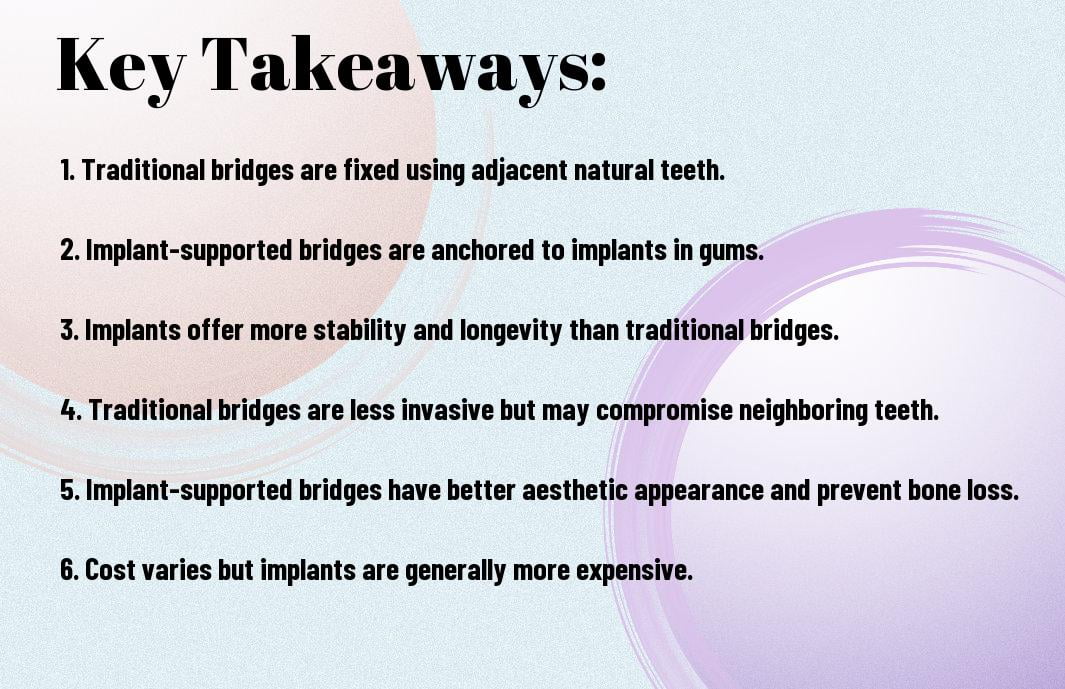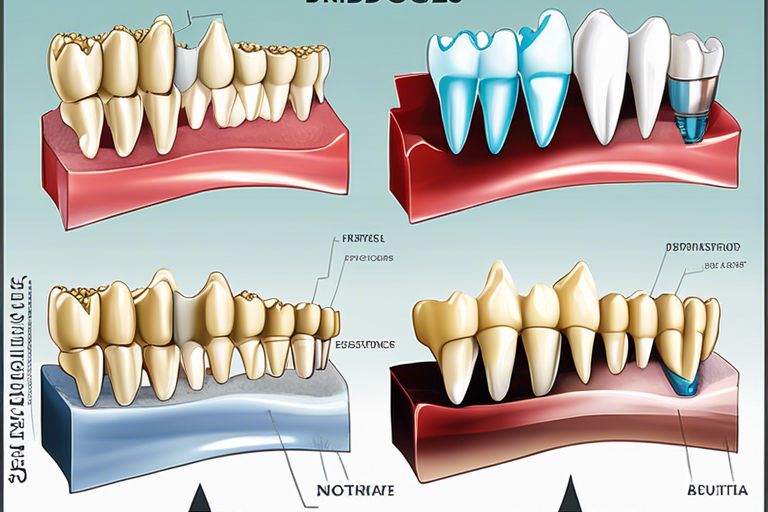Many factors can influence your decision when considering traditional versus implant-supported dental bridges. Understanding the differences between the two options can help you make an informed choice that best suits your needs. Let’s explore key differences in durability, maintenance, cost, and overall functionality to determine which type of dental bridge may be the right choice for you.
Key Takeaways:
- Traditional Bridges: They are a more cost-effective option compared to implant-supported bridges.
- Implant-Supported Bridges: Provide better durability and prevent bone loss compared to traditional bridges.
- Consultation with a Dentist: It is imperative to consult with a dentist to determine the best option based on your individual needs and oral health.
What are Traditional Dental Bridges?
Definition and History
What exactly are traditional dental bridges? These bridges are a common restorative option used to replace one or more missing teeth. They consist of two crowns placed on the abutment teeth on either side of the gap, with a false tooth (or teeth) in between to fill the space left by the missing tooth. Traditional bridges have been a staple in dentistry for decades, providing patients with a reliable solution for restoring their smile and bite.
How They Work
Traditional dental bridges work by anchoring the false tooth or teeth in place using the adjacent natural teeth as support. The abutment teeth are prepared by removing some enamel to allow for the placement of crowns, which are then cemented onto these teeth, securing the bridge in place. The false tooth in the middle fills the gap, restoring your smile and preventing the surrounding teeth from shifting out of place.
The Advantages of Traditional Dental Bridges
Cost-Effective
Even though traditional dental bridges may not be as technologically advanced as implant-supported bridges, they are a cost-effective option for replacing missing teeth. Any budget-conscious individual may find traditional bridges more accessible compared to the higher cost associated with implant-supported bridges.
Quick Procedure
The installation of traditional dental bridges is usually a quick procedure that can be completed in a few visits to the dentist. The process involves preparing the adjacent teeth, taking impressions, and fitting the custom-made bridge. The entire process can be completed in a matter of weeks.
The speed of the traditional bridge procedure is advantageous for individuals who want a relatively fast solution to their missing teeth. Unlike the implant-supported bridges that require healing time for the implant to integrate with the jawbone, traditional bridges can provide a quicker restoration of your smile and chewing function.
Wide Availability
With traditional dental bridges being a well-established dental procedure, they are widely available in dental clinics around the world. Whether you are in a big city or a rural area, you can easily find a dentist who can provide you with traditional bridge options.
Dental professionals have been placing traditional bridges for decades, making it a common and well-practiced treatment in the field of dentistry. You can trust that your dentist has the expertise and experience to ensure a successful outcome with your traditional bridge.
The Disadvantages of Traditional Dental Bridges
All traditional dental bridges come with their own set of disadvantages that you should be aware of before making a decision.
Limited Durability
On the downside, traditional bridges have a limited lifespan compared to implant-supported bridges. The materials used in traditional bridges may wear down over time, leading to a need for replacement or repair.
Affects Adjacent Teeth
Traditional dental bridges require the alteration of the adjacent teeth to support the bridge. This means that healthy teeth on either side of the gap need to be filed down significantly to accommodate the bridge. This irreversible process can weaken the supporting teeth and make them more susceptible to decay or damage in the future.
Adjacent teeth may also be prone to increased sensitivity as a result of the preparation required for a traditional dental bridge. This can lead to discomfort when eating or drinking hot or cold foods and beverages.
Bone Loss and Shifting
Durability is a concern with traditional bridges when it comes to the underlying bone structure. The absence of tooth roots can lead to bone loss over time, which may cause the jawbone to deteriorate and contribute to a change in your facial structure.
Affects can also include the potential for the surrounding teeth to shift or move out of alignment due to the lack of stimulation from the missing tooth root. This can impact your bite and overall oral health in the long run.
What are Implant-Supported Dental Bridges?
Definition and History
On the cutting edge of dental technology, implant-supported dental bridges are a modern solution to missing teeth that offer superior stability and functionality compared to traditional bridges. Unlike their counterparts, which rely on adjacent teeth for support, implant-supported bridges are anchored directly into the jawbone through the use of titanium implants.
How They Work
Dental implants act as artificial tooth roots, providing a sturdy foundation for the bridge to be attached securely. This process involves a minor surgical procedure where the implants are placed into the jawbone and left to integrate and heal over a few months. Once the implants have fused with the bone, custom-made crowns or a bridge are mounted on top, resulting in a strong and durable tooth replacement option.
Work
Implant-supported bridges not only look and feel like natural teeth but also prevent bone loss and maintain the integrity of the facial structure. By mimicking the function of natural teeth roots, they provide the necessary stimulation to the jawbone, promoting its health and longevity.
The Advantages of Implant-Supported Dental Bridges
Long-Lasting and Durable
Keep in mind that when it comes to choosing between traditional and implant-supported bridges, durability is a key factor to consider. Implant-supported bridges are known for their longevity and durability. Once placed by your dentist, they integrate with your jawbone, becoming a permanent part of your mouth. This means that with proper care and maintenance, they can last a lifetime, saving you from the hassle and cost of frequent replacements.
Natural Look and Feel
Long-lasting implant-supported bridges offer a natural look and feel that closely resemble your natural teeth. The materials used for these bridges are designed to mimic the color and translucency of your original teeth, blending seamlessly with the rest of your smile. You no longer have to worry about metal clasps or hooks that may be visible with traditional bridges, giving you the confidence to smile and speak without any self-consciousness.
The result of implant-supported bridges is a restoration that not only looks natural but also feels comfortable in your mouth. Unlike removable dentures that can shift or click while eating or speaking, implant-supported bridges are securely anchored in place, providing stability and functionality that are similar to your own teeth.
Preserves Bone Structure
Feel reassured that choosing implant-supported bridges can help preserve your bone structure over time. When you lose a tooth, the surrounding bone may start to deteriorate due to lack of stimulation. Placing an implant in the jawbone helps to mimic the natural tooth root’s function, stimulating the bone and preventing further bone loss. By maintaining the integrity of your jawbone, implant-supported bridges contribute to your overall oral health and facial structure.
Another benefit of preserving your bone structure with implant-supported bridges is that it keeps adjacent teeth stable and prevents them from shifting into the gap left by the missing tooth. This helps to maintain proper alignment and bite function, further enhancing the longevity of your dental health.
The Disadvantages of Implant-Supported Dental Bridges
Higher Cost
Disadvantages of opting for implant-supported dental bridges over traditional bridges include the higher cost associated with this advanced dental procedure. Implant-supported bridges involve the placement of titanium posts into the jawbone to support the bridge, which requires precision surgery and expertise. As a result, the overall cost of implant-supported bridges can be significantly higher compared to traditional bridges.
Longer Procedure Time
Time is another factor to consider when deciding between traditional bridges and implant-supported bridges. The process of receiving implant-supported bridges can take longer than getting traditional bridges. This is because implant-supported bridges involve multiple stages, including the surgical placement of the implants, a healing period for the jawbone to fuse with the implants, and the attachment of the bridge. This extended timeline may not be suitable for individuals looking for a quicker dental solution.
This longer procedure time for implant-supported bridges is crucial to ensure the success and longevity of the dental restoration. Rushing through any of the stages can compromise the outcome and lead to potential issues in the future.
Requires Surgery
For some individuals, the idea of undergoing oral surgery may be a deterrent to choosing implant-supported dental bridges. Unlike traditional bridges that simply anchor to existing teeth, implant-supported bridges require the surgical placement of titanium posts into the jawbone. This surgical aspect of the procedure can be intimidating for those who are not comfortable with invasive dental treatments.
Higher cost, longer procedure time, and the requirement for surgery are important factors to consider when deciding between traditional and implant-supported dental bridges. It’s vital to weigh these disadvantages against the benefits of implant-supported bridges to make an informed decision that best suits your dental needs and preferences.
Final Words
The decision between traditional and implant-supported dental bridges ultimately comes down to your individual needs and preferences. Traditional bridges offer a more cost-effective solution that can still provide aesthetic and functional benefits. On the other hand, implant-supported bridges offer greater stability and longevity but come with a higher price tag. Consider consulting with your dentist to discuss which option aligns best with your oral health goals and budget.
The most important thing is to prioritize your overall oral health and address any missing teeth promptly to prevent further complications. Whether you opt for a traditional bridge or an implant-supported one, both options can effectively restore your smile and confidence. Bear in mind, your dentist is there to guide you through the decision-making process and help you achieve optimal dental health.
FAQ
Q: What are traditional dental bridges?
A: Traditional dental bridges are dental prosthetics that use the surrounding natural teeth to support the false tooth or teeth in between. These bridges are made of materials like porcelain, metal, or a combination of both.
Q: What are implant-supported dental bridges?
A: Implant-supported dental bridges are prosthetics that are supported by dental implants surgically placed into the jawbone. These implants act as artificial roots for the bridge, providing stability and preventing bone loss in the jaw.
Q: How do I determine which type of dental bridge is right for me?
A: The choice between traditional and implant-supported bridges depends on various factors such as your oral health, jawbone density, budget, and personal preferences. Your dentist will assess your individual needs and discuss the pros and cons of each option to help you make an informed decision.







